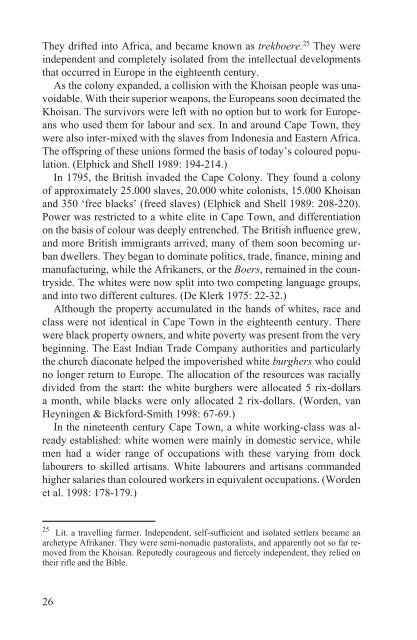The Making of a Good White - E-thesis - Helsinki.fi
The Making of a Good White - E-thesis - Helsinki.fi
The Making of a Good White - E-thesis - Helsinki.fi
Create successful ePaper yourself
Turn your PDF publications into a flip-book with our unique Google optimized e-Paper software.
<strong>The</strong>y drifted into Africa, and became known as trekboere. 25 <strong>The</strong>y were<br />
independent and completely isolated from the intellectual developments<br />
that occurred in Europe in the eighteenth century.<br />
As the colony expanded, a collision with the Khoisan people was unavoidable.<br />
With their superior weapons, the Europeans soon decimated the<br />
Khoisan. <strong>The</strong> survivors were left with no option but to work for Europeans<br />
who used them for labour and sex. In and around Cape Town, they<br />
were also inter-mixed with the slaves from Indonesia and Eastern Africa.<br />
<strong>The</strong> <strong>of</strong>fspring <strong>of</strong> these unions formed the basis <strong>of</strong> today’s coloured population.<br />
(Elphick and Shell 1989: 194-214.)<br />
In 1795, the British invaded the Cape Colony. <strong>The</strong>y found a colony<br />
<strong>of</strong> approximately 25.000 slaves, 20.000 white colonists, 15.000 Khoisan<br />
and 350 ‘free blacks’ (freed slaves) (Elphick and Shell 1989: 208-220).<br />
Power was restricted to a white elite in Cape Town, and differentiation<br />
on the basis <strong>of</strong> colour was deeply entrenched. <strong>The</strong> British influence grew,<br />
and more British immigrants arrived, many <strong>of</strong> them soon becoming urban<br />
dwellers. <strong>The</strong>y began to dominate politics, trade, <strong>fi</strong>nance, mining and<br />
manufacturing, while the Afrikaners, or the Boers, remained in the countryside.<br />
<strong>The</strong> whites were now split into two competing language groups,<br />
and into two different cultures. (De Klerk 1975: 22-32.)<br />
Although the property accumulated in the hands <strong>of</strong> whites, race and<br />
class were not identical in Cape Town in the eighteenth century. <strong>The</strong>re<br />
were black property owners, and white poverty was present from the very<br />
beginning. <strong>The</strong> East Indian Trade Company authorities and particularly<br />
the church diaconate helped the impoverished white burghers who could<br />
no longer return to Europe. <strong>The</strong> allocation <strong>of</strong> the resources was racially<br />
divided from the start: the white burghers were allocated 5 rix-dollars<br />
a month, while blacks were only allocated 2 rix-dollars. (Worden, van<br />
Heyningen & Bickford-Smith 1998: 67-69.)<br />
In the nineteenth century Cape Town, a white working-class was already<br />
established: white women were mainly in domestic service, while<br />
men had a wider range <strong>of</strong> occupations with these varying from dock<br />
labourers to skilled artisans. <strong>White</strong> labourers and artisans commanded<br />
higher salaries than coloured workers in equivalent occupations. (Worden<br />
et al. 1998: 178-179.)<br />
25 Lit. a travelling farmer. Independent, self-suf<strong>fi</strong>cient and isolated settlers became an<br />
archetype Afrikaner. <strong>The</strong>y were semi-nomadic pastoralists, and apparently not so far removed<br />
from the Khoisan. Reputedly courageous and <strong>fi</strong>ercely independent, they relied on<br />
their rifle and the Bible.<br />
26
















